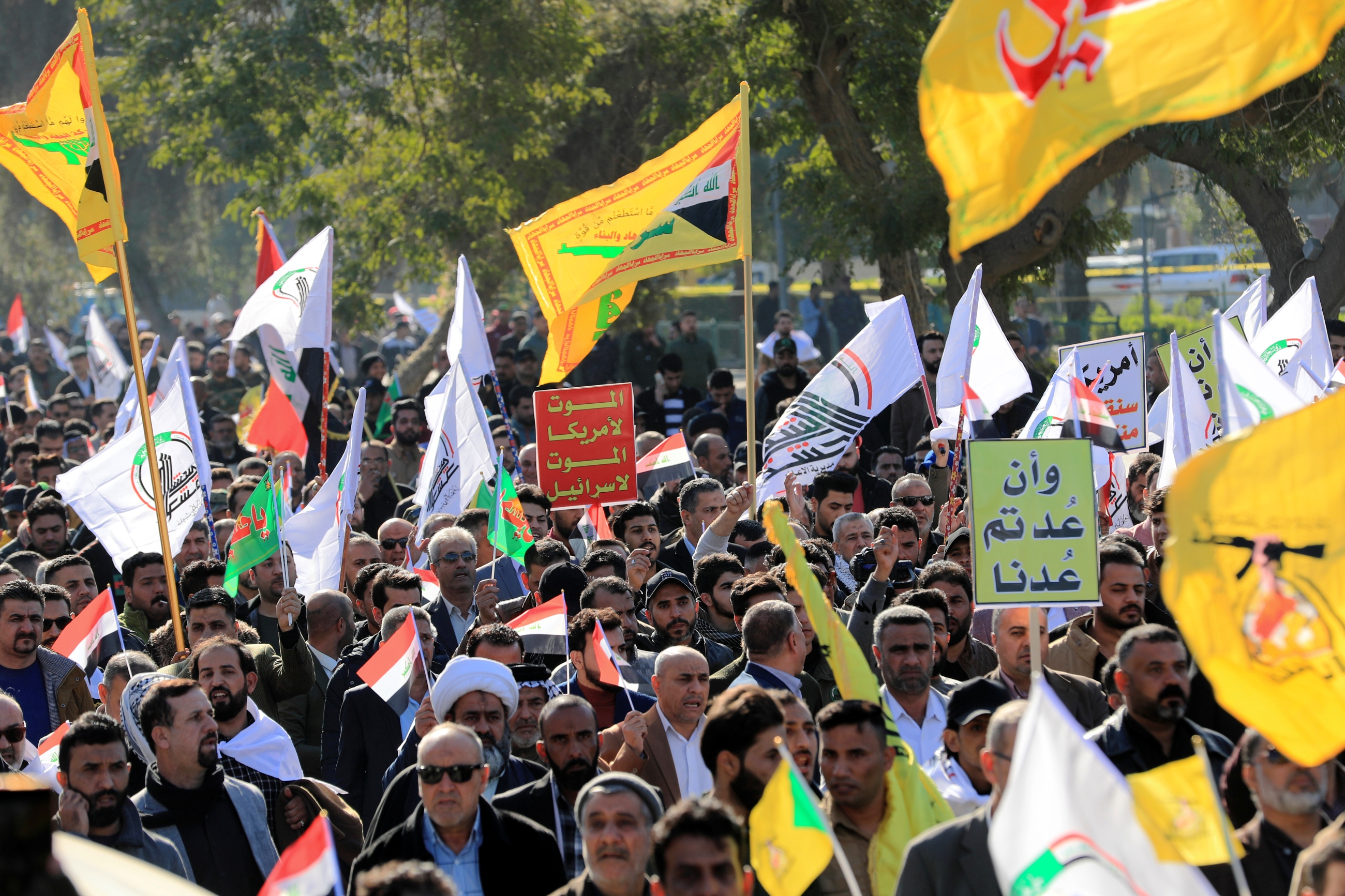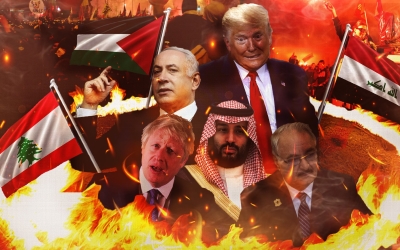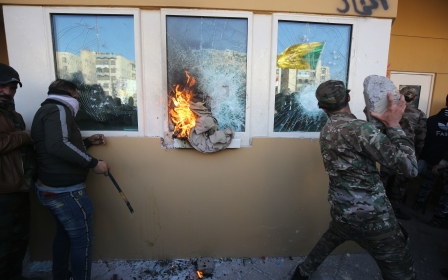Following US strikes, Iran to consolidate militia alliances despite rising costs

US air strikes against the Iran-backed Kataib Hezbollah (KH) militia group have once again exposed grave risks and vulnerabilities in Tehran’s regional security strategy, characterised by the mobilisation and deployment of non-state actors for defensive and offensive purposes.
The 29 December strikes on five KH targets in Iraq and Syria, including weapons storage facilities and command and control sites near the Al-Qaim border area, killed at least 25 and wounded 55 fighters. Four KH local commanders and three Iranian missile experts from the Quds Force, foreign operations arm of Iran’s Islamic Revolutionary Guard Corps (IRGC), are among the fatalities, according to local Iraqi sources.
New MEE newsletter: Jerusalem Dispatch
Sign up to get the latest insights and analysis on Israel-Palestine, alongside Turkey Unpacked and other MEE newsletters
US Defense Secretary Mark Esper described the offensive as a “successful” response to a series of rocket attacks against the K1 military base near Kirkuk on 27 December that killed an American defence contractor and wounded four US service members as well as two Iraqi security officers.
It was the deadliest US assault yet against a state-sanctioned Iraqi Popular Mobilisation Forces (PMF, or Hashd al-Shaabi) paramilitary outfit backed by the Islamic Republic.
While these types of kinetic operations, also increasingly conducted by Israel against Iranian installations in Syria, have arguably raised the cost of surrogate warfare for Iran, they are expected to make Tehran more rather than less reliant on its regional patronage network of non-state allies.
Tug of war
“Mobilising paramilitary groups under the ‘axis of resistance’ umbrella is one of the most important components of Iran’s deterrence strategy against an adversarial constellation of US alliances and coalitions in the Middle East,” Saheb Sadeghi, Tehran-based managing director of the Iranian magazine Diplomat, told Middle East Eye (MEE).
“Facilitating the spread of Iranian clout in Iraq, Syria, Lebanon and Yemen, this policy has also enhanced Tehran’s missile defence capability in terms of geographical access to potential targets.”
In a fiery statement on Monday, the IRGC condemned the US offensive in Al-Qaim district as “criminal” and stressed the PMF's “right to retaliate”, endorsing an earlier Kataib Hezbollah pledge to exact revenge for the “aggression of evil American ravens.”
Shortly after the air strikes, a military base hosting US forces in Taji, near the Iraqi capital Baghdad, reportedly came under fire from four Katyusha rockets.
A decisive reprisal by the Revolutionary Guard or its Shia militia allies arguably risks escalating Iran-US tensions out of control and sparking a major military confrontation between the two adversaries that would likely engulf the whole region.
Even if Tehran opts out of this course of action for fear of triggering a devastating and ultimately unwinnable war, it will probably capitalise on the Al-Qaim incident to further a case for the expulsion of American forces from Iraqi territory, as calls for an end to US military presence in the war-torn country are gaining momentum.
“The K1 rocket attacks, which elicited American air strikes against Kataib Hezbollah positions, seem to have been an attempt by the IRGC to deflect attention from increasing popular resentment with Tehran’s self-interested role in Iraq as well as its bloody crackdown on mass protests across Iran itself,” Mohammad Manzarpour, CEO of US-based news production firm Persis Media, told MEE.
“And apparently, it is working.”
Maximum pressure
The US military operation against Kataib Hezbollah came at a time of mounting domestic and international pressure on the Iranian leadership to wind down its support for paramilitary groups in the region. Concurrent anti-government protests across Iran and two of its most vital partners, Iraq and Lebanon, have posed an almost unprecedented bottom-up challenge to the Islamic Republic’s popular support base and regional standing.
With the exception of Lebanon, where Tehran’s chief non-state ally Hezbollah has tried to contain anti-establishment protests, security forces in both Iran and Iraq have killed hundreds of demonstrators to crush the unrest.
“The leadership in Tehran believes that these protest movements have been incited by Washington and its regional allies as part of the US “maximum pressure” policy against the Islamic Republic, or are at least being hijacked by them and turned into a tool to undermine governments that are friendly to Iran,” Heiko Wimmen, project director for Iraq, Syria and Lebanon at the Brussels-based International Crisis Group, told MEE.
“From their perspective, it’s an added layer of pressure in a hostile strategy of diplomatic isolation, economic strangulation and military encirclement that is eventually aimed at regime change.”
In rare defiance of Iranian efforts to preserve the old guard in Iraq following the resignation of Prime Minister Adel Abdul Mahdi, Iraqi President Barham Salih threatened to step down in the face of pressure to approve the nomination of Asaad al-Edani, a former minister and governor of oil-rich Basra province proposed by the Iran-backed Binaa voting bloc in Iraq’s parliament.
The Binaa grouping consists mostly of Fatah party MPs led by Hadi al-Ameri, head of the pro-Iran Badr Organisation. Binaa is deeply engaged in political competition with the Sairoon bloc marshalled by populist Shia cleric Muqtara al-Sadr who has denounced both Tehran and Washington for turning Iraq into an arena for their destabilising geopolitical rivalry.
“While the majority of PMF groups who answered Grand Ayatollah Sistani’s fatwa to defeat [the Islamic State] have no motivation to be part of a US-Iran conflict, Iraq’s Shia political theatre is mainly controlled by the religious parties that are somehow taking the side of Iran,” Ismael al-Sodani, a former Iraqi defence attache to the United States, told MEE.
“Generally the bonds between these parties and the Islamic Republic are too strong to be broken for any reason in the foreseeable future,” he added.
Escalatory cycle
Tehran might also resort to non-military retaliation by adopting a deliberately drastic countermeasure in rolling back its restrictive commitments under the 2015 Iran nuclear deal – officially known as the Joint Comprehensive Plan of Action (JCPOA) – from which the Trump administration unilaterally withdrew in May 2018 before reimposing crippling sanctions on the Iranian economy.
Tehran’s fifth nuclear countermeasure is due on 5-6 January.
European signatories to the JCPOA - Britain, France and Germany - have threatened to trigger a dispute resolution process enshrined in the agreement, to deter Tehran from stepping further away from compliance with its nuclear obligations.
The process can ultimately lead to the reimposition or so-called “snapback” of all UN Security Council sanctions against the Islamic Republic that were lifted under the UNSC Resolution 2231 in 2015.
On their part, Iranian leaders have warned they will jettison the JCPOA and even leave the Non-Proliferation Treaty (NPT) if the snapback mechanism is activated.
This escalatory cycle could culminate in Israeli or American military action to prevent what will likely be perceived as an Iranian “breakout” towards nuclear weaponisation.
In the absence of reliable conventional alliances, the Islamic Republic will continue to rely on Shia militia allies to protect its vital interests in a regional conflagration.
“The synergistic entanglement of Iran’s missile capability and unconventional alliances with paramilitary groups has become an indispensable component of its deterrence strategy and defence posture, so much so that it is almost impossible to abandon or replace anytime soon,” Sadeghi concluded.
Middle East Eye delivers independent and unrivalled coverage and analysis of the Middle East, North Africa and beyond. To learn more about republishing this content and the associated fees, please fill out this form. More about MEE can be found here.







